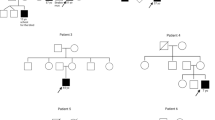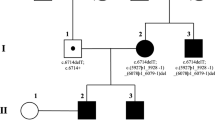Abstract
X–linked juvenile retinoschisis (RS) is a recessively inherited vitreo-retinal degeneration characterized by macular pathology and intraretinal splitting of the retina. The RS gene has been localized to Xp22.2 to an approximately 1 Mb interval between DXS418 and DXS999/DXS7161. Mapping and expression analysis of expressed sequence tags have identified a novel transcript, designated XLRS1, within the centromeric RS locus that is exclusively expressed in retina. The predicted XLRS1 protein contains a highly conserved motif implicated in cell–cell interaction and thus may be active in cell adhesion processes during retinal development. Mutational analyses of XLRS1 in affected individuals from nine unrelated RS families revealed one nonsense, one frameshift, one splice acceptor and six missense mutations segregating with the disease phenotype in the respective families. These data provide strong evidence that the XLRS1 gene, when mutated, causes RS.
This is a preview of subscription content, access via your institution
Access options
Subscribe to this journal
Receive 12 print issues and online access
$209.00 per year
only $17.42 per issue
Buy this article
- Purchase on SpringerLink
- Instant access to full article PDF
Prices may be subject to local taxes which are calculated during checkout
Similar content being viewed by others
References
Haas, J. Ueber das Zusammenvorkommen von Veraenderungen der Retina und Choroidea. Arch. Augenheilkd. 37, 343–348 (1898).
Deutman, A.F. Vitreoretinal dystrophies. In Hereditary Retinal and Choroidal Diseases (eds Krill, A. & Archer, D.B.) 1043–1108 (Harper & Row, New York, 1977).
Kawano, K., Tanaka, K., Murakami, F. & Ohba, N. Congenital hereditary retinoschisis: evolution at the initial stage. Arch. Clin. Exp. Ophthalmol. 217, 315–323 (1981).
George, N.D., Yates, J.R. & Moore, A.T. Clinical features in affected males with X-linked retinoschisis. Arch. Ophthalmol. 114, 274–280 (1996).
Kellner, U., Brummer, S., Foerster, M.H. & Wessing, A. X-linked congenital retinoschisis. Arch. Clin. Exp. Ophthalmol. 228, 432–437 (1990).
Forsius, H. et al. Visual acuity in 183 cases of X-chromosomal retinoschisis. Can. J. Ophthalmol. 8, 385–393 (1973).
Reichenbach, A. & Robinson, S.R. The involvement of Müller cells in the outer retina. in Neurobiology and Clinical Aspects of the Outer Retina (eds Djamgoz, M.B.A., Archer, S.N. & Vallerga, S.) 395–415 (Chapman and Hall, London, 1995).
Miller, R.F. & Dowling, J.E. Intracellular responses of the Müller (glial) cells of mudpuppy retina: their relation to b-wave of the electroretinogram. J. Neurophysiol. 33, 323–341 (1970).
Arden, G.B., Gorin, M.B., Polkinghorne, P.J., Jay, M. & Bird, A.C. Detection of the carrier state of X-linked retinoschisis. Am. J. Ophthalmol. 105, 590–595 (1988).
Sheffield, J.B. & Li, H.P. Interactions among cells of the developing neural retina in vitro. Am. Zool. 27, 145–159 (1987).
Kljavin, I.J. & Reh, T.A. Muller cells are a preferred substrate for in vitro neurite extension by rod photoreceptor cells. J. Neurosci. 11, 2985–2994 (1991).
Ives, E.J., Ewing, C.C. & Innes, R. X-linked juvenile retinoschisis and Xg linkage in five families. Am. J. Hum. Genet. 22, A17–A18 (1970).
Wieacker, P. et al. Linkage relationships between retinoschisis, Xg, and a cloned DNA sequence from the distal short arm of the X chromosome. Hum. Genet. 64, 143–145 (1983).
Alitalo, T., Kama, J., Forsius, H. & de la Chapelle, A.E. X-linked retinoschisis is closely linked to DXS41 and DXS16 but not DXS85. Clin. Genet. 32, 192–195 (1987).
Weber, B.H.F. et al. X-linked juvenile retinoschisis (RS) maps between DXS987 and DXS443. Cytogenet. Cell. Genet. 69, 35–37 (1995).
van de Vosse, E. et al. An Xp22.1–p22.2 YAC contig encompassing the disease loci for RS, KFSD, CLS, HYP and RP15: refined localization of RS. Eur. J. Hum. Genet. 4, 101–104 (1996).
Hupaniemi, L., Rantala, A., Tahvanainen, E., de la Chapelle, A. & Alitalo, T. Linkage disequilibrium and physical mapping of X-linked juvenile retinoschisis. Am. J. Hum. Genet. 60, 1139–1149 (1997).
Alitalo, T. et al. A 6-Mb YAC contig in Xp22.1–p22.2 spanning the DXS69E, XE59, GLRA2, PICA, GRPR, CALB3, and PHKA2 genes. Genomics 25, 691–700 (1995).
Ferrero, G.B. et al. An integrated physical and genetic map of a 35 Mb region on chromosome Xp22.3–Xp21.3. Hum. Mol. Genet. 4, 1821–1827 (1995).
Nehls, M., Pfeifer, D. & Boehm, T. Exon amplification from complete libraries of genomic DNA using a novel phage vector with automatic plasmid excision facility: application to the mouse neurof ibromatosis-1 locus. Oncogene 9, 2169–2175 (1994).
Rommens, J.M. et al. A transcription map of the region containing the Huntington disease gene. Hum. Mol. Genet. 2, 901–907 (1993).
Uberbacher, E.C. & Mural, R.J. Locating protein-coding regions in human DNA sequences by a multiple sensor-neural network approach. Proc. Natl. Acad. Sci. USA 88, 11261–11265 (1991).
Kozak, M. Interpreting cDNA sequences: some insights from studies on translation. Mamm. Genome 7, 563–574 (1996).
Gierasch, L.M. Signal sequences. Biochemistry 28, 923–930 (1989).
Springer, W.R., Cooper, D.N. & Barondes, S.H. Discoidin I is implicated in cell-substratum attachment and ordered cell migration of Dictyostelium discoideum and resembles fibronectin. Cell 39, 557–564 (1984).
Kotani, E. et al. Cloning and expression of the gene of hemocytin, an insect humoral lectin which is homologous with the mammalian von Willebrand factor. Biochim. Biophys. Acta 1260, 245–258 (1995).
Takagi, S. et al. The A5 antigen, a candidate for the neuronal recognition molecule, has homologies to complement components and coagulation factors. Neuron 7, 295–307 (1991).
Takagi, S. et al. Expression of a cell adhesion molecule, neuropilin, in the developing chick nervous system. Dev. Biol. 170, 207–222 (1995).
Kawakami, A., Kitsukawa, T., Takagi, S. & Fujisawa, H. Developmental regulated expression of a cell surface protein, neuropilin, in the mouse nervous system. J. Neurobiol. 29, 1–17 (1996).
Stubbs, J.D. et al. cDNA cloning of a mouse mammary epithelial cell surface protein reveals the existence of epidermal growth factor-like domains linked to factor VIII–like sequences. Proc. Natl. Acad. Sci. USA 87, 8417–8421 (1990).
Larocca, D. et al. A Mr 46,000 human milk fat globule protein that is highly expressed in human breast tumors contains factor VIII–like domains. Cancer Res. 51, 4994–4998 (1991).
Cripe, L.D., Moore, K.D. & Kane, W.H. Structure of the gene for human coagulation factor V. Biochemistry 31, 3777–3785 (1992).
Truett, M.A. et al. Characterization of the polypeptide composition of human factor VIII:C and the nucleotide sequence and expression of the human kidney cDNA. DNA 4, 333–349 (1985).
Elder, B., Lakich, D. & Gitschier, J. Sequence of the murine factor VIII cDNA. Genomics 16, 374–379 (1993).
Perez, J.L. et al. Identification and chromosomal mapping of a receptor tyrosine kinase with a putative phospholipid binding sequence in its ectodomain. Oncogene 9, 211–219 (1994).
Penotti, F.E. Human pre-mRNA splicing signals. J. Theor. Biol. 150, 385–420 (1991).
Kane, W.H. & Davie, E.W. Blood coagulation factors V and VIII: structural and functional similarities and their relationsship to hemorrhage and thrombic disorders. Blood 71, 539–555 (1988).
Arai, M., Scandella, D. & Hoyer, L.W. Molecular basis of factor VIII inhibition by human antibodies: antibodies that bind to the factor VIII light chain prevent the interaction of factor VIM with phospholipid. J. Clin. Invest. 83, 1978–1984 (1989).
Rosen, S.D., Kafka, J.A., Simpson, D.L. & Barondes, S.H. Developmentally regulated, carbohydrate-binding protein in Dictyostelium discoideum. Proc. Natl. Acad. Sci. USA 70, 2554–2557 (1973).
Manschot, W.A. Pathology of hereditary juvenile retinoschisis. Arch. Ophthalmol. 88, 131–138 (1972).
Yanoff, M., Kertesz-Rahn, E. & Zimmerman, L.E. Histopathology of juvenile retinoschisis. Arch. Ophthalmol. 79, 49–53 (1968).
Condon, G.P., Brownstein, S., Wang, N.S., Kearns, J.A. & Ewing, C.C. Congenital hereditary (juvenile X-linked) retinoschisis: histopathologic and ultrastructural findings in three eyes. Arch. Ophthalmol. 104, 576–583 (1986).
Molday, R.S., Hicks, D. & Molday, L. Peripherin: a rim-specific membrane protein of rod outer segment discs. Invest Ophthalmol. Vis. Sci. 28, 50–61 (1987).
Felbor, U., Schilling, H. & Weber, B.H.F. Adult vitelliform macular dystrophy is frequently associated with mutations in the peripherin/RDS gene. Hum. Mutat. (in the press).
Weber, B.H.F., Vogt, G., Pruett, R.C., Stöhr, H. & Felbor, U. Mutations in the tissue inhibitor of metalloproteinases-3 (TIMP3) in patients with Sorsby's fundus dystrophy. Nature Genet. 8, 352–356 (1994).
Allikmets, R. et al. A photoreceptor cell-specific ATP-binding transporter gene (ABCR) is mutated in recessive Stargardt macular dystrophy. Nature Genet. 15, 236–246 (1997).
Church, C.M. & Gilbert, W. Genomic sequencing. Proc. Natl. Acad. Sci. USA 81, 1991–1995 (1984).
Chomczynski, P. & Sacchi, N. Single-step method of RNA isolation by acid guanidinium-thiocyanate-phenol-chloroform extraction. Anal. Biochem. 162, 156–159 (1987).
Ewing, C.C. & Ives, E.J. Juvenile hereditary retinoschisis. Trans. Ophthalmol. Soc. UK 89, 29–39 (1970).
Genetics Computer Group. Program Manual for Wisconsin Package, Version 9, Madison, Wisconsin, 1996.
Corpet, F. Multiple sequence alignment with hierarchical clustering. Nucleic Acids Res. 16, 10881–10890 (1988).
Fukuzawa, M. & Ochiai, H. Molecular cloning and characterization of the cDNA for discoidin II of Dictyostelium discoideum. Plant Cell Physiol. 37, 505–514 (1996).
Author information
Authors and Affiliations
Corresponding author
Rights and permissions
About this article
Cite this article
Sauer, C., Gehrig, A., Warneke-Wittstock, R. et al. Positional cloning of the gene associated with X-linked juvenile retinoschisis. Nat Genet 17, 164–170 (1997). https://doi.org/10.1038/ng1097-164
Received:
Accepted:
Issue Date:
DOI: https://doi.org/10.1038/ng1097-164



